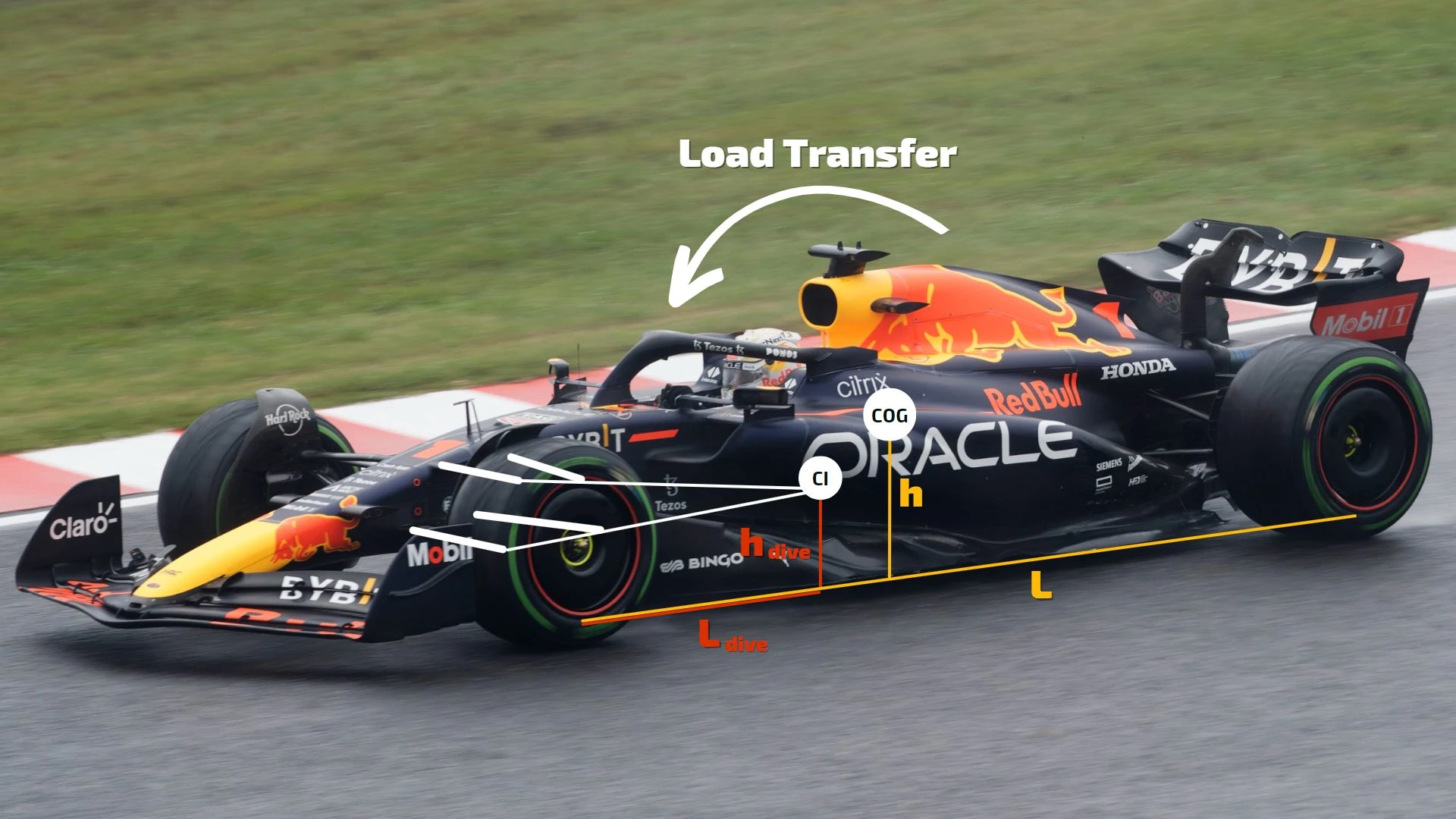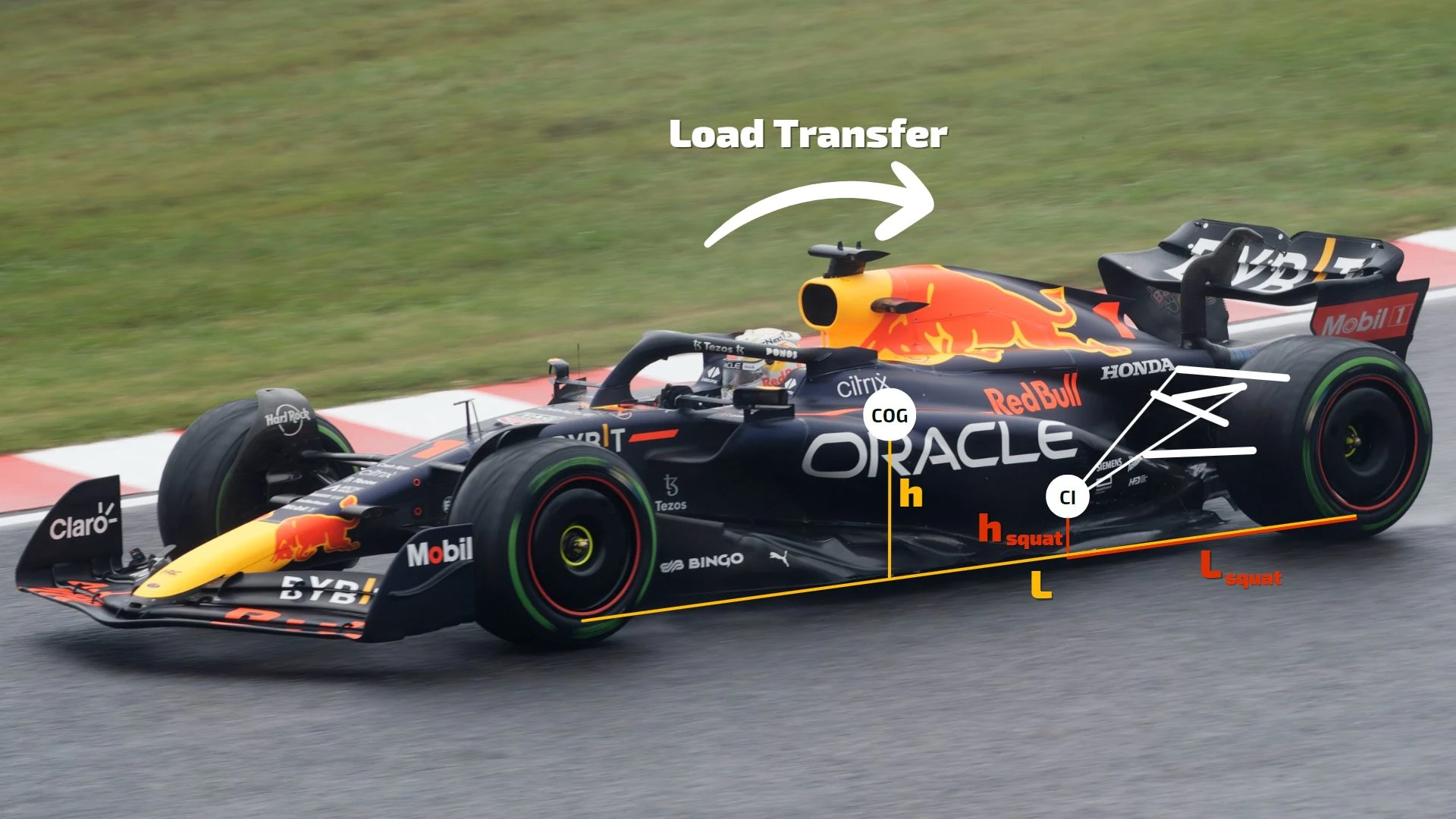
A deep dive into the anti-dive! How an F1 “anti-dive” and “anti-squat” suspension works
This year in Formula 1 there is much talk of the "anti-dive" and "anti-squat" suspension systems adopted by each team on their single-seaters. The integration of these two characteristics, respectively on the front and rear suspensions, is often indicated as the cause of a great advantage (or, conversely, disadvantage) of one team over another... But is it really so? And how do such suspensions work?
What is the level of interaction between suspension and aerodynamics in Formula 1?
When it comes to suspension in relation to aerodynamics on a Formula 1 car, the simplest interaction one can think of is the positioning of the suspension wishbones, that "direct" the downstream airflow in accordance with the aerodynamic philosophy chosen in the design phase.
But for a long time now, suspensions have actually had a much more important task: to keep the vehicle body at a constant ride height. If we think about it, in fact, a suspension literally keeps the car raised from the ground, absorbing all the obstacles encountered along a lap by the wheels (which, not surprisingly, are called "unsprung masses").
Since most of the aerodynamic effects of a single-seater are due to the efficiency of the underfloor - especially with the current technical regulations - it is immediately clear that exploiting the ground effect can only be possible if the vehicle body does not incur in significant shaking.
In fact, when a vehicle changes its ride height due to any phenomenon (passing over a curb, porpoising, transient phases, etc.) the aerodynamic load it is able to generate is much lower than the so-called "design" conditions. But if the suspensions are designed in such a way as to counteract this effect, you can always keep very close to the design conditions, and performance is optimized as a result.
What happens when braking and when accelerating?
The problem for those who design the suspensions of a Formula 1 car is that the variations in height from the ground are not something sporadic, like a passage over a curb; on the contrary, with each braking and acceleration there are movements typically defined as "dive" and "squat":
- The term dive literally means the drop of the front end under braking;
- The term squat refers to the phenomenon whereby the car "sits" on its rear axle during acceleration;
Much more important, however, is to understand why these phenomena arise... the main cause is in fact something on which very little can be done, namely the arrangement of the masses inside the vehicle!
Any body with its own mass has an associated "center of mass", i.e. a point where virtually all the mass of the body itself is concentrated. This center of mass, also often called "center of gravity" (COG), is for example located in humans near the navel: this explains why gymnasts lift themselves with the navel beyond the bar to facilitate the rotation around it.
Glenn Dunbar / Motorsport Images
And in Formula 1? Well, there the goal is to keep the COG as low as possible, but generally engineers manage to stay close to the height of the drivers’ head, using the next image as a reference.
How an anti-dive suspension system works
When a driver approaches the braking zone, the inertia tends not only to push the vehicle forward, but also to generate a "moment" which induces the rotation of the car around the front axle. We therefore have what is defined as load transfer, by means of which the rear axle is “lightened” and the front axle is more pressed to the ground: this is why we speak literally of dropping. If the design of the single-seaters were such as to completely ignore this phenomenon (obviously a crazy hypothesis, both in Formula 1 and in road vehicles), it would even lead to a flip!
Instead, in order to take into account the important problem of the dive, the geometry of the front suspension must be such as to naturally counteract the aforementioned dropping. It is even possible to calculate an anti-dive percentage: ideally, having 0% means totally ignoring the dive itself, while having 100% means that the front end will not have the slightest downward movement under braking (fascinating hypothesis, but still detrimental to performance).

Let's look at the image above: being a Formula 1 car equipped with a "double wishbone" suspensions layout (i.e. with two triangles, one above the other), each of the two triangles will have its own leaning angle with respect to the ground... If we imagine then, in side view, to draw a line connecting the two attachment points of the upper wishbone - and then we do the same thing for the lower wishbone, we will get two lines meeting at one point. This point, called "instantaneous front center", will have a certain distance both in length (Ldive) and in height (hdive) with respect to the contact patch of the front tyres.
Considering then that the F1 cars are equipped with a "brake balance" system which shifts the distribution of braking forces between the front and rear axle - according to the wishes of the driver - what follows is that the braking system is often biased towards front end. Generally the balance goes from 55% FRONT - 45% REAR to 65% FRONT - 35% REAR. As we can see below, the brake balance (indicated as the percentage referring to the front end) is also included in the calculation of the anti-dive percentage:

As can be seen in the formula just shown, in addition to the suspension layout, the wheelbase of the car "L" and the vertical position of the COG "h" also have an influence in determining how much anti-dive effect is expressed. In particular, as the wheelbase increases (which we remember is the distance from the axis of the front wheels to that of the rear wheels) the anti-dive increases as well: since last year all the teams have tried to increase the wheelbase also for this reason, as well as to have more vehicle surface area useful for generating aerodynamic downforce.
As for the effect of the front suspension geometry alone, to increase the anti-dive effect it may be useful to design two converging wishbones, for example by lowering the attachment point of the rear arm (speaking of the upper wishbone). It is a geometry on which Red Bull has focused a lot, both with last year's RB18 and with this year’s RB19.
There are even rumors of an angle between the two suspension triangles close to 45°, while among the other single-seaters on the grid there are values close to 15°: perhaps it is no coincidence that the suspension was the area of the car under the direct supervision of Adrian Newey, who therefore - once again - made the difference compared to the rivals.
How does the anti-squat at the rear work?
A rear suspension layout that encourages the anti-squat effect tries to prevent the car from "sitting" on the rear axle during acceleration. This lowering of the rear takes place for an exactly symmetrical reason with respect to what was said about the anti-dive: when accelerating, there is indeed a load transfer due to inertial effects, but towards the rear! It should therefore come as no surprise that this squat reduces the stability of the car when exiting corners, where it becomes much easier to run into power oversteers and, potentially, spins.
Zak Mauger / Motorsport Images
Before understanding how a rear suspension with an anti-squat effect can be designed, to better understand what has been said so far, a type of vehicle where the inertial effects are felt much more than in Formula 1 will help us: we are talking about racing motorcycles, mostly from MotoGP or Superbike.
In these cases, we see how the front suspension drops under braking, to the point of observing the rear tyre lifting off the ground: this is the perfect example of a 100% load transfer from the rear to the front! On the contrary, just think of a wheelie to have a counterexample of 100% load transfer from the front to the rear.

In Formula 1, since we are dealing with 4-wheeled vehicles, the very geometry of the single-seaters avoids reaching the extremes just mentioned, but when it comes to reducing laptime, every physical phenomenon that intervenes on the car must be fine-tuned and/or optimized.
And so we come to the evergreen problem of the anti-squat: as you may have already understood, the definition of the percentage of anti-squat is totally similar to what was said for the anti-dive.

The formula above highlights several of the considerations already made in the previous paragraph: to increase the anti-squat effect it is good to have a single-seater with a long wheelbase, with a COG as low as possible, and rear suspension wishbone geometries such as the instantaneous rear center is close (vertically speaking) to the contact patch of the rear tyres.
What is irrelevant, however, is the percentage of braking balance (BBal [%]), contrary to what was seen at the front in the case of the anti-dive. As you will understand, even at the rear it is not wise in the design phase to choose a suspension layout close to 100% anti-squat: the driver must always be able to "feel" the movements of the car in response to his driving inputs, and a very high anti-squat percentage would worsen the driver feeling a lot.
Why don't Red Bull's rivals adopt an accentuated anti-dive like that of the RB19?
Judging by the way we have explained the subject, you might think that it is too simple for everyone to design suspensions that increase the two mentioned effects… but then why doesn’t anyone do it?
Reality is often much more complicated than a mathematical theory: in fact we have talked about anti-dive and anti-squat in an "isolated" way, as if in the complex dynamics that govern the motion of a Formula 1 car there were no other phenomena to consider.
In truth, the so-called "longitudinal dynamics" that we have dealt with should be accompanied by transversal dynamics, to understand how load transfers from left to right (and vice versa) affect the overall behavior of a car. As a result, the design of the suspensions must take into account numerous trade-off choices between needs related to longitudinal and transversal dynamics…
But we will deal with this in another article. For now, goodbye!
Index
A deep dive into the anti-dive! How an F1 “anti-dive” and “anti-squat” suspension works